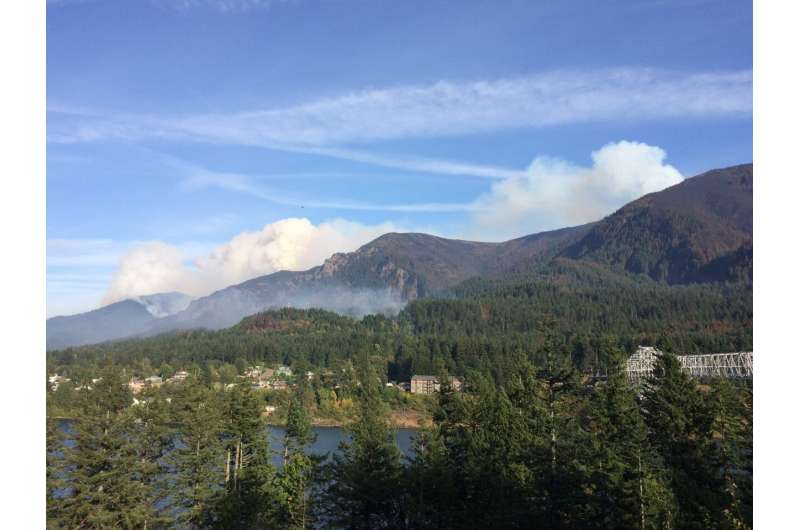'Digital footprints' central to new approach for studying post-disturbance recreation changes

The Columbia River Gorge is a crown jewel for recreation in the Pacific Northwest, stretching more than 80 miles along the borders of Washington and Oregon and providing a wide variety of trails, campgrounds, waterfalls, and wilderness areas for recreational use. In 2017, the western portion of the area was burned by the Eagle Creek Fire, a human-caused, wind-driven blaze that ultimately burned nearly 50,000 acres and caused temporary closures of some of the most popular sites in the area.
Trends show that outdoor recreation is increasing, but so, too, are the rates of wildfires and other disturbances. The challenge for managers, then, is providing future recreation opportunities in this dynamic environment.
Research social scientist Eric White is the lead of a new study that applies a novel approach to study the effects of the 2017 Eagle Creek Fire on recreation visitation in the Gorge. This approach is especially promising for large areas, like the Gorge, whose recreation is managed by a patchwork of groups, ranging from federal agencies, like the U.S. Department of Agriculture, Forest Service; to state agencies; private timber companies; and nonprofit organizations.
This management tapestry can make visitation trends, which are critical to recreation management, more difficult to collate and analyze.
Along with his University of Washington coauthors, Samantha Winder and Spencer Wood, White estimated visitation at 41 sites in the Gorge, largely trails, including those directly affected and damaged by the Eagle Creek Fire and those unaffected but likely to serve as substitute recreation sites during the closures.
The research team applied a visitation model to the sites that relates visits to a variety of influencing factors, including weather, occurrence of holidays, seasonality, and volume of social media shared by visitors to each site. They incorporated publicly available posts from the social media platforms Twitter, Instagram, and Flickr, along with the trail review website, AllTrails, into the visitation model to more fully estimate the number of visits to each of the 41 study sites three years before and two years after the fire.
"Our study of pre- and post-fire recreation was possible because we developed and applied methods using social media to 'hindcast' recreation visits to discrete locations spanning a large landscape," White said.
In hindcasting, the research team used the digital footprints from the past to estimate, in hindsight, the amount of recreation at trails and other sites in the years before the Eagle Creek Fire. That was important because traditional recreation visitation data, such as traffic counts or visitor interviews, didn't exist for all of the study sites.
The team was then able to use those hindcasted visitation patterns before the Eagle Creek Fire to model what visitation would have been in the years after the fire when recreation was disrupted and sites were closed. Using social media data to hindcast visitation allowed the team to create a complete picture of the visitation in the Gorge and how it changed over time.
Before these new approaches, the only way to count the number of visitors at recreation sites was through automatic counters, reservation systems, or manager visits. So, if managers or researchers wanted to know how visitation changed over time or after a fire, they had to have those systems in place for many years.
For the most part, that traditional data hasn't been collected widely in places like the Gorge and other large landscapes with multiple land ownerships and inconsistent, or nonexistent, recreation monitoring practices—meaning it was previously difficult or impossible to quantify recreation use and understand how disturbances and subsequent management responses influenced recreation patterns.
"This study shows how using new approaches that draw from social media data can help us better understand the complex relationships between wildfire, natural resource management, and people," White said. "It also highlights the importance of ensuring managers have the needed tools and resources to reopen recreation sites as soon as possible after wildfire or other disturbance."
Highlights
- The recent trends of increasing visitation in the Columbia River Gorge reversed in the first two years after the Eagle Creek Fire, as recreation sites affected by the human-caused wildfire were closed so that managers could assess damage and make repairs.
- It did not appear that recreationists chose to visit other, adjacent sites in the Gorge that remained open during the temporary closures—a phenomenon known as "site substitution"— likely due to an unwillingness to travel longer distances.
- Before the closures, the western edge of the Gorge received the most recreation visits, but during the closures, sites in the eastern portion of the Gorge accounted for nearly all visitation in the two years following the fire—a redistribution of recreation activity with management implications.
- Visitation rebounded to pre-fire levels at all sites except one, supporting the idea that recreation visitation losses following wildfire are temporary.
- Although social media data offers great promise for learning about recreation use patterns, caution is still warranted as data can be limited, especially for low-use trails, and reliance on data from just one platform likely misses some types of recreation visitors.
The research is published in the journal Society & Natural Resources.
More information: Eric M. White et al, Applying Novel Visitation Models using Diverse Social Media to Understand Recreation Change after Wildfire and Site Closure, Society & Natural Resources (2022). DOI: 10.1080/08941920.2022.2134531
Provided by USDA Forest Service




















